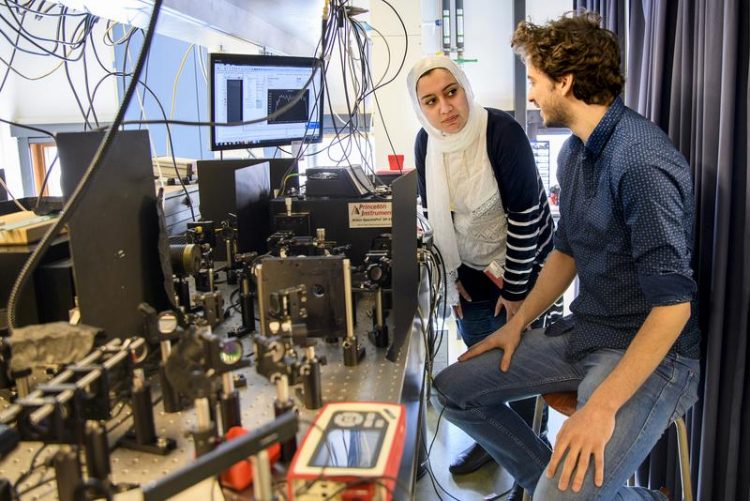Light-emitting silicon-germanium alloys: breakthrough on the way to photonic computing

First authors Elham Fadaly (left) and Alain Dijkstra (right) at their optical setup to measure the emission of light from the hexagonal-SiGe nanowires. Sicco van Grieken, SURF / TU/e
Electronic chips produce heat when processing data. The laptop starts to feel uncomfortably hot on the user's knees; data centers need energy-hungry cooling equipment. The solution may lie in the field of photonics – because light pulses do not emit heat.
For the past half century, this insight has driven efforts by researchers to build silicon or germanium-based lasers – so far in vain. Silicon, the workhorse of the chip industry, normally crystallizes in a cubic crystal lattice. In this form it is not suitable for converting electrons into light.
Together with colleagues from the Technical University of Munich and the universities in Jena and Linz, researchers at the Technical University of Eindhoven have now developed alloys made of germanium and silicon capable of emitting light.
The crucial step was the ability to produce germanium and alloys from germanium and silicon with a hexagonal crystal lattice. “This material has a direct band gap, and can therefore emit light itself,” says Prof. Jonathan Finley, Professor of Semiconductor Quantum Nanosystems at TUM.
The template trick
Prof. Erik Bakkers and his team at TU Eindhoven first produced hexagonal silicon back in 2015. They started by growing a hexagonal crystal structure with nanowires made of another material. This served as a template for a germanium-silicon shell on which the underlying material imposed its hexagonal crystal structure.
Initially, however, these structures could not be stimulated to emit light. Through the exchange of ideas with colleagues at the Walter Schottky Institute at the Technical University of Munich, who analyzed the optical characteristics with each successive generation, the production process was finally optimized to a grade of perfection where the nanowires were indeed capable of emitting light.
“In the meantime, we have achieved properties almost comparable to indium phosphide or gallium arsenide,” says Prof. Bakkers. As a result, it appears to be just a matter of time before a laser made from germanium-silicon alloys and capable of integration into conventional production processes is developed.
“If we can implement on-chip and inter-chip electronic communications by optical means, speeds can be increased by a factor of up to 1,000,” says Jonathan Finley. “In addition, the direct combination of optics and electronics could drastically reduce the cost of chips for laser-based radar in self-driving cars, chemical sensors for medical diagnostics, and air and food quality measurements.”
The research project received funding from the European Union (EU) project, SiLAS, the Marie Sklodowska Curie Programme of the EU, the Dutch Research Council (NWO), the Solliance Initiative of the Energy research Centre of the Netherlands (ECN), the Holst Center, the TU/e, the Netherlands Organization for Applied Scientific Research (TNO), the Interuniversity Microelectronics Centre (IMEC), the Forschungszentrum Jülich and the province of North Brabant in the Netherlands. The Deutsches Elektronen Synchrotron (DESY) in Hamburg provided measurement time on the PETRA III facility. Theoretical calculations were carried out on the SuperMUC high-performance computer at the Leibniz Supercomputing Center in Garching, Germany.
Prof. Dr. Jonathan J. Finley
Walter Schottky Institute and Department of Physics
Technical University of Munich
Am Coulombwall 4, 85748 Garching, Germany
Tel.: +49 89 289 12770 – e-mail: jonathan.finley@wsi.tum.de
Direct Bandgap Emission from Hexagonal Ge and SiGe Alloys
E. M. T. Fadaly, A. Dijkstra, J. R. Suckert, D. Ziss, M. A. J. v. Tilburg, C. Mao, Y. Ren, V. T. v. Lange, S. Kölling, M. A. Verheijen, D. Busse, C. Rödl, J. Furthmüller, F. Bechstedt, J. Stangl, J. J. Finley, S. Botti, J. E. M. Haverkort, E. P. A. M. Bakkers.
Nature, 8. April 2020 – DOI: 10.1038/s41586-020-2150-y
https://www.nature.com/articles/s41586-020-2150-y Original publication (link effective after embargo has lifted)
https://www.wsi.tum.de/views/groups.php?group=finley Homepage of Prof. Finley's group
https://www.tue.nl/en/research/researchers/erik-bakkers/ Homepage of Prof. Bakkers' group
https://www.silasproject.eu/ Homepage of the SiLAS-project
Media Contact
All latest news from the category: Information Technology
Here you can find a summary of innovations in the fields of information and data processing and up-to-date developments on IT equipment and hardware.
This area covers topics such as IT services, IT architectures, IT management and telecommunications.
Newest articles

A chip unique in the world
A team from UPV and iPRONICS has manufactured the first universal, programmable and multifunctional photonic chip on the market. A team from the Photonics Research Laboratory (PRL)-iTEAM of the Universitat…

Advance in light-based computing
…shows capabilities for future smart cameras. UCLA-developed experimental device demonstrates ability to reduce glare in images. Researchers developing the next generation of computing technology aim to bring some light to…

Evidence for reversible oxygen ion movement during electrical pulsing
…enabler of the emerging ferroelectricity in binary oxides. In a recent study published in Materials Futures, researchers have uncovered a pivotal mechanism driving the emergence of ferroelectricity in binary oxides….





















